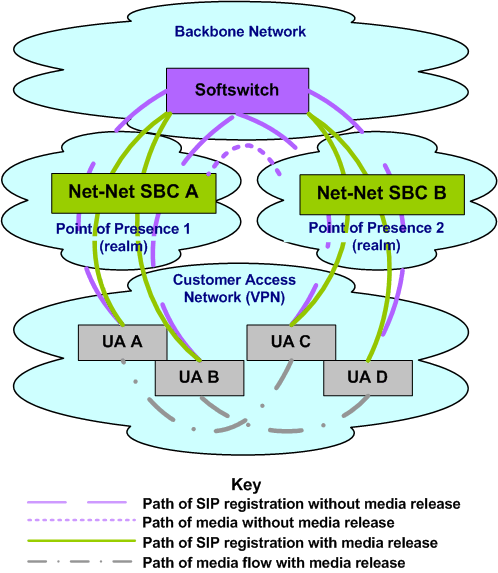SIP Distributed Media Release
This section explains how to configure distributed media release (DMR). SIP DMR lets you choose whether to include multi-system (multiple Oracle® Enterprise Session Border Controllers) media release information in SIP signaling requests sent into a specific realm.
Overview
The SIP DMR feature lets RTP/RTCP media be sent directly between SIP endpoints (for example, SIP phones or user agents) without going through a Oracle® Enterprise Session Border Controller; even if the SIP signaling messages traverse multiple Oracle® Enterprise Session Border Controllers. It encodes IPv4 address and port information for the media streams described by the media, for example SDP.
With SIP DMR, the media realm and IPv4 address and port information from the UA's SDP is encoded into SIP messages (either in the SIP header or in the SDP) as they enter the backbone network. The information is decoded by a Oracle® Enterprise Session Border Controller from SIP messages that come from the backbone network. The decoded address and port information is put into the SDP sent the UAs in the access (private/customer) network.
This functionality lets the RTP/RTCP flow directly between the UAs in the access network without traversing the Oracle® Enterprise Session Border Controllers and without passing into the backbone network. The media can then flow directly between the two SIP endpoints in the same network, if it is serviced by multiple Oracle® Enterprise Session Border Controllers.
You can enable this feature on a per-realm basis and multiple realms can be supported.
Endpoint Locations
You can configure the Oracle® Enterprise Session Border Controller to release media when the source and destination of the call are in the same network, customer VPN, or customer LAN. In architectures that use DMR, the Oracle® Enterprise Session Border Controller is only part of the media path for traffic that originates and terminates in different networks.
If configured to do so, the Oracle® Enterprise Session Border Controller can release media:
- Between endpoints supported by a single
Oracle® Enterprise Session Border Controller
In the same network/VPN
In the same network behind the same NAT/firewall
- Between endpoints supported by multiple distributed
Oracle® Enterprise Session Border Controllers
In the same network/VPN
Location of the Encoded Information
Encoded media release information can appear in three different places:
- SDP attribute
Media release data can be encoded into an SDP attribute in the SIP message body (for example, media-release=sdp;acme-media). The encoded data is placed into an acme-media attribute in the SDP:
a=acme-media:<encoded-media-interface-info>
- SIP header parameter
Media release data can be placed in a header parameter of a SIP header (for example, media-release=Contact;acme-media). The encoded data is placed into an acme-media parameter in the Contact header:
Contact: <sip:1234@abc.com>;acme-media=<encoded-media-interface-info>
- SIP header
Media release data can appear in a SIP header (for example, media-release=P-Media-Release). The encoded data is placed into a P-Media-Release header:
P-Media-Release: <encoded-media-interface-info>
Example Distributed Media Release
The following example shows the network diagram for DMR in a multiple-site VPN environment supported by multiple, distributed Oracle® Enterprise Session Border Controllers.

As shown in the network diagram, UA A and UA B register with the softswitch through Oracle® Enterprise Session Border Controller A while UA C and UA D register with the softswitch through Oracle® Enterprise Session Border Controller B. Without DMR, the media for calls between UA A/UA B and UA C/UA D is steered through both Oracle® Enterprise Session Border Controller A and Oracle® Enterprise Session Border Controller B.
With SIP DMR, the media realm and IPv4 address and port information from the UA's Session Description Protocol (SDP) is encoded into SIP messages (either in the SIP header or in the SDP) as they enter the backbone (public/service provider) network. The information is decoded from SIP messages that come from the backbone network. The decoded address and port information is put into the SDP sent to the UAs in the access (private/customer) network. This functionality allows for the RTP/RTCP to flow directly between the UAs in the access network without traversing the Oracle® Enterprise Session Border Controllers and without passing into the backbone network.
SIP DMR Configuration
To configure media release:
Configuring the Realm
You need to set the each realm config element’s msm release field to enabled for all the realms for which you want to use SIP DMR.
Although the mm in network field is not specific to the SIP distributed media release feature, it can be used to release the media back to a connected network that has multiple realms. This field does not need to be configured in order for the SIP distributed media release feature to work. However, if this field is set to enabled and the ingress and egress realms are part of the same network interface, it lets the Oracle® Enterprise Session Border Controller release the media.



